Many merchants end up concluding that their customers just don’t want to write reviews. At the same time, the need to generate reviews is more apparent than ever.
While it’s true that today’s consumers have notoriously short attention spans and a million other things to do besides write reviews, they do want to share their experiences and if you know how to ask correctly, you can definitely succeed in getting more customer reviews and building stronger relationships with your consumers in the process.
For this guide, we studied data from over 2 million reviews to bring you the best proven tactics, from basic tips to advanced strategies.
How to get customer reviews, at a glance:
- Make it possible
- Just ask!
- Make it mobile friendly
- Ask at the right time, in the right way
- Get more reviews on expensive products
- Get reviews for products no one wants to review
- Reward your customers
1. Make it possible
It may seem obvious, but it’s important: In order for customers to leave reviews, you need to make it possible for them to write them!
That means prominently featuring calls-to-action for customers to leave a review on your site.
Look at how Beardbrand shows a clear call to action to leave a review on every product page:

2. Just ask!
Asking for a review from your customers isn’t difficult, but too many stores forget to do it. Again, customers are much more likely to leave reviews when you prompt them.
Remind your customers to leave reviews as much as possible. While they may write a review from your site, data shows that the best way to get responses is to ask via email after the customers receive their order.
If you want testimonials about your service or on-site experience, ask customers for reviews after they’ve interacted with your store in some way.
Look at how Expedia asks for reviews after customers have booked a trip.
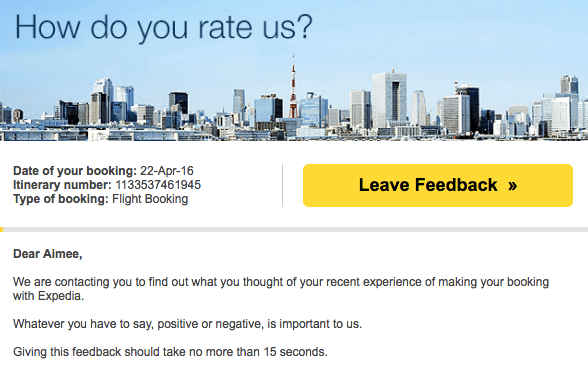
Another common strategy is asking for reviews after customers have had a customer service question answered. That way, customers interaction with your brand is top of mind, and the request isn’t out of the blue.
3. Make it easy, make it mobile
Many store owners wonder how to encourage customers to write reviews in the most effective way. The trick is to make it super easy for customers to write and submit reviews, no matter where they are or what they’re doing.
People are happy to contribute content when you take all the work out of it — don’t make them click through several pages, and don’t ask them to log in.
This is by far the most important step to getting more reviews.
Make sure that your reviewing process isn’t bogged down with details and multiple steps. If it is, you may lose those customers whose inspiration fades in the face of a complicated reviewing platform.
Companies with simple review processes often have more customer reviews simply because their platform was easily accessible and they engaged the customer before they lost interest.

A follow-up email harnesses the post-purchase momentum, when a customers’ opinion of the product and experience with your brand is fresh in their mind.
An extra tip? Make sure it feels personalized, not salesy. Keep the tone warm and lighthearted, and be sure to use the opportunity to build a stronger relationship with your customer. Let them know how much you appreciate them taking the time to give you feedback.
Also, make sure your review request process is mobile. A lot of businesses are quick to ensure their product pages and checkouts are mobile, but they drop the ball when it comes to asking for reviews.
Mobile is important: 56% of Yotpo reviews come from mobile, so you need to make sure your request is mobile friendly.
4. Ask at the right time, in the right way
Data shows that there’s a serious science to asking for reviews – down to how to create the perfect subject line based on your industry, and what time of day is best to ask.
For example, review response rates jump by almost 20% between 1-3pm — probably because people are just getting back to their desks and emails after lunch and aren’t ready to jump into their work yet. When sending review requests manually, be sure to take timing into account to increase effectiveness.
See the full report, or check out our video breaking down subject line data below, and learn how to collect reviews in the most effective way.
5. Get more reviews for expensive products
If someone makes a purchase of multiple products, which one should you ask for reviews on?
A lot of brands choose to do this randomly.
Our data shows that expensive products get more reviews – so it’s most effective to ask for reviews on the most expensive product.
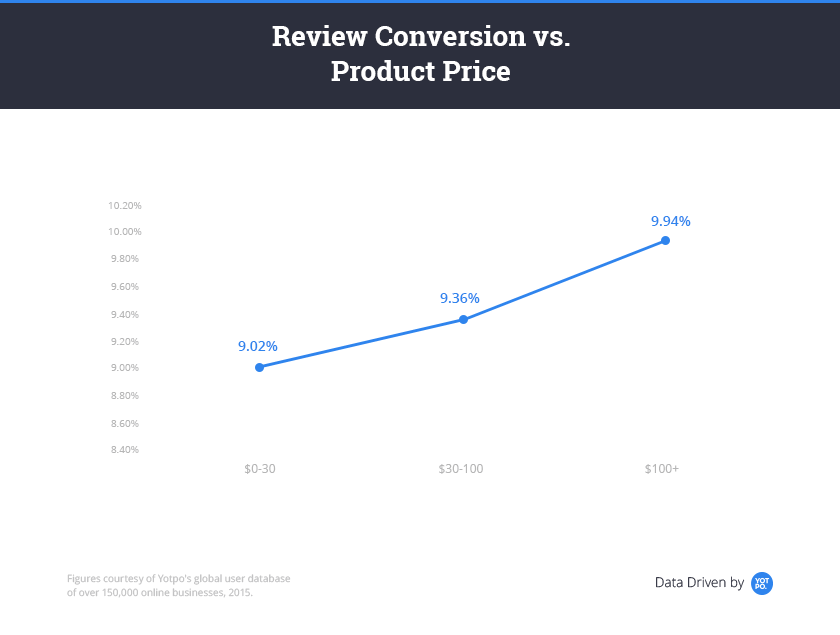
Review conversion rates increase the more expensive a product gets, with products that cost $100 or more getting the most reviews.
6. Get reviews for products no one wants to review
It’s important to have an even distribution of reviews across your products. It’s not good for sales to just have a few products with tons of reviews, and others with very few.
In order to get the most sales from product reviews, you need to consistently get fresh reviews on many of your products. But that’s easier said than done.
Feel like there’s some products that just aren’t getting reviews, no matter how hard you try?
Learn how to get more reviews for the products no one wants to review.
7. Reward your customers for their reviews
If you have a smart review generation strategy and you still need to get more reviews, there is no replacement for giving rewards.
People are more likely to give when they have an incentive – so give customers that final push by offering them a reward for writing a review.
Some businesses like to offer points or raffles. We’ve found that coupons are really effective — one for writing a review, and an additional one for sharing it on social channels.
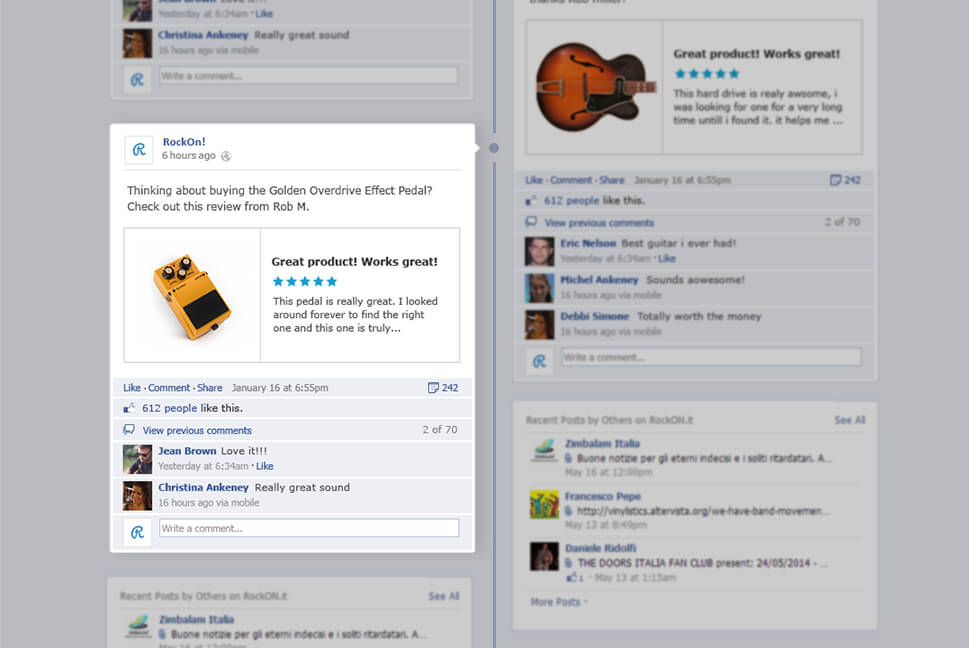
This accomplishes a few things:
1) Customers are more likely to write a review
2) You get the explosive publicity of them sharing it with their friends & family (who are likely also in your target market and happy to hear a recommendation from a friend)
Also, they become a repeat customer when they come back to your store to use the coupon (and then write another review).
Encourage participation by creating customized competitions and campaigns that are fueled and inspired by your customers’ reviews. Show them that what they’re saying is being heard and make posting a review a small price to pay for a shoutout on social media or their specific idea being put into action.
Integrate reviews into other user-generated content platforms to engage customers through a variety social media, streamlining your brand and encouraging sharing.
For example, post a photo of your product on Facebook with a few specific questions and ask for opinions.
The casual platform combined with the direct questions will encourage responses from people who may not otherwise reach out.
It’s not necessarily about what you ask, but where and how you ask it.
How to Get More Reviews on Facebook
Since eCommerce is shifting to social platforms, getting customer reviews on your social channels is key. How can you get more reviews on Facebook?
- Feature your best reviews in Facebook ads
- Share your top reviews with your followers
- Incentivize your customers to share their reviews on Facebook
- Install the Yotpo Reviews Tab on your Facebook page to import your on-site reviews to your business page
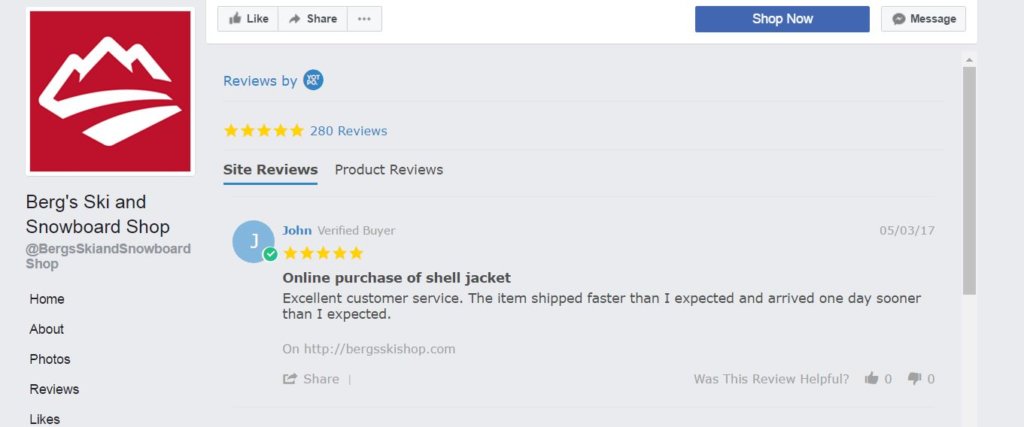
How to Get Google Reviews to Work for You
- Collect site reviews in addition to product reviews to qualify for a Google Seller Ratings
- Make sure your reviews have both title and body text to meet Google’s standards
- Keep reviews on your site, rather than on a third-party site, to boost SEO
- Enable reviews on your Google Product Listing Ads
What To Do Once You’re Getting More Reviews
Knowing how to encourage customers to leave reviews is important, but what you do next is crucial to getting the full benefits from them.
So once you have reviews, how can you make the most of them? These strategies help your reviews go a long way.
Respond to reviewers
Mastering customer reviews is a two-part process: part one is getting the customer reviews, and part two is making sure your customers know you want to continue the conversation.
Be sure to respond!
This sounds like a no-brainer, but when your customers say something to you — whether through a customer review, Facebook comment, Tweet, etc. — respond to them as promptly as you can so they know that their input matters and is appreciated.
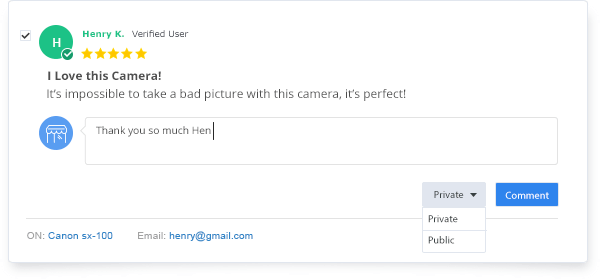
There are few customer experiences more frustrating than asking a company a question and receiving radio silence on the other end.
Responding to customers quickly and authentically shows that you’re on top of your game and hones customer trust and loyalty by reminding them that your brand is made of real people who care.
It also allows you to further engage and communicate with your customers, which is the point of customer reviews to begin with.
The review process empowers your customers, and responding to their reviews validates this empowerment and encourages future reviews.
Upsell when you ask for reviews
When writing a good review, your past customers are actively thinking about the positive customer experience they had with your brand — this is the perfect time to offer another great experience.
Take a personalized approach to upselling to effectively influence consumer behavior.
Consider their past purchases, their shopping behavior, how highly the related products are rated, and other data to determine the products that specific person is most likely to buy.
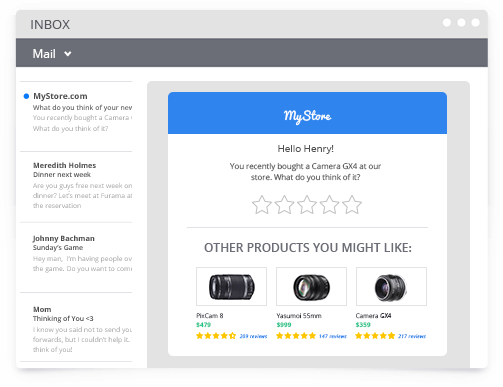
Data from our stores shows that 7% of the people who click on these smart email upsells end up making another purchase.
Use Negative Reviews to Your Advantage
No company wants to receive a negative review, but the good news is that showing negative reviews actually improves customer trust.
Negative reviews shown alongside positives ones emphasize their authenticity and proves to the customer that they haven’t been doctored.
They also offer a unique marketing opportunity when handled correctly. Communicating with the customer and addressing the negative review directly builds customer confidence in your brand.
Make sure to answer the negative review promptly with a personalized response, one that faces their complaint head-on and cites specific details, so it doesn’t come off as standardized.
Offer a sincere apology and ask for a second chance to have their business, potentially with an incentive.
Once the wrong has been righted, ask them to write another review of their experience, which will show potential customers that you are willing to go the distance to take care of your customers and make them feel heard.
The Impact of Reviews & Testimonials on Your Business
Putting in all this effort to get more reviews and to respond properly to the ones you receive will pay off. A survey of more than 600 online shoppers reveals that 77.3% of people say reviews impact their decision to make a purchase.
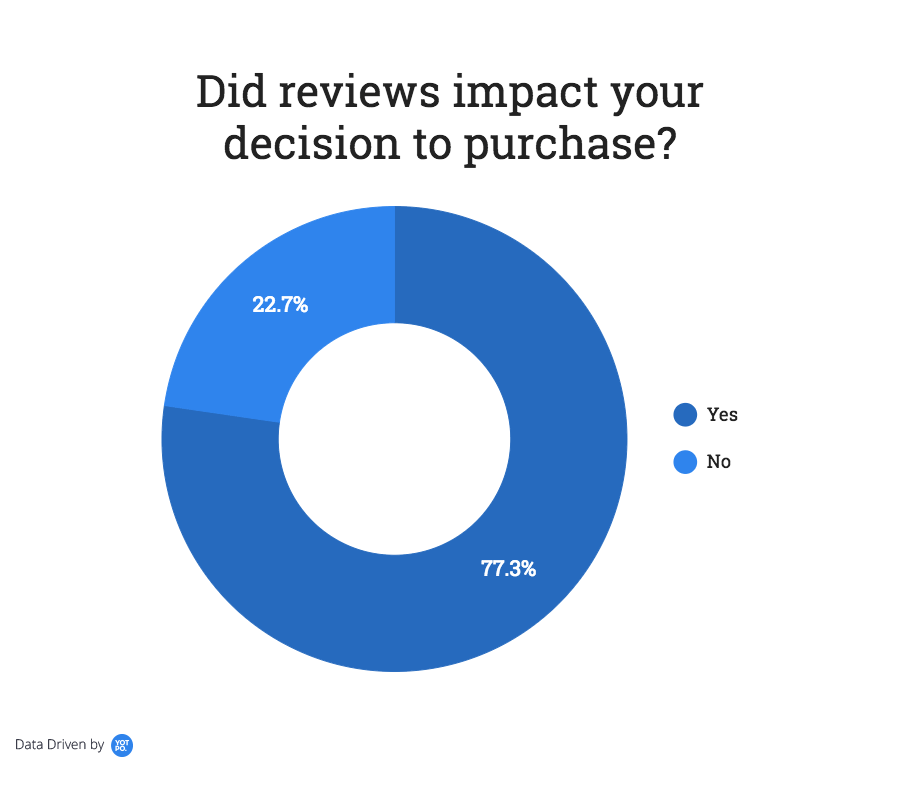
Most stores that sell online know they need product reviews as part of their eCommerce marketing plan. But what many people don’t know is that all stores also need site testimonials.
Site reviews matter for all businesses – not just eCommerce stores. They should be a part of any eCommerce or local SEO checklist, since they have an impact on brand visibility.
Also, it’s important that you own your review content rather than hosting it on third-party review sites like Google reviews, Yelp, TrustPilot, Facebook, etc.
Why?
Having reviews on your site allows you to rank highest in Google searches, bringing traffic to your store instead of other sites.
When people search for reviews of Pura Vida Bracelets, the official site shows up first in search results, because they own their review content.
So instead of traffic going to Yelp, traffic comes directly to Pura Vida’s site, making potential customers more likely to purchase.
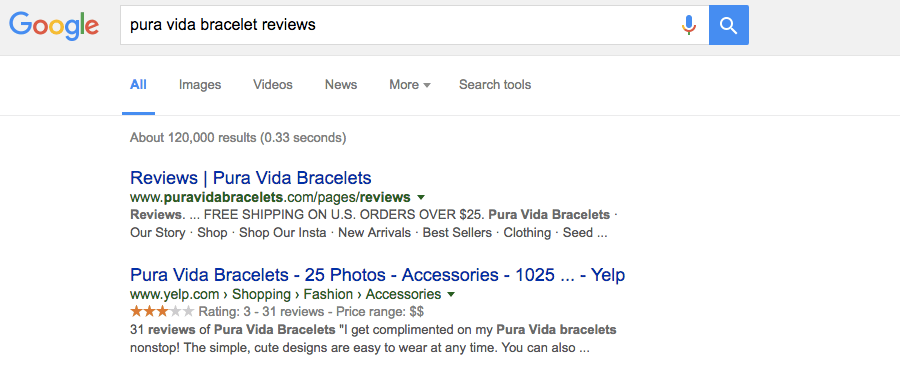
And traffic from reviews is super valuable. Yotpo data shows that review traffic is the most engaged, with shoppers staying longer and navigating furthest into the site.
Traffic coming from reviews has a lower bounce rate and higher page views than traffic coming from Google, Facebook, and Twitter.
Also, owning your content ensures that you have complete control over your reviews.
You can protect the authenticity of your reviews, use the content in marketing, and respond to negative reviews.
Conclusion
Getting customer reviews and knowing the best way to leverage them to drive sales is challenging, but it doesn’t have to be complicated.
Yotpo makes it easy for you to get more authentic customer reviews, leverage them in marketing, and use them to improve conversion rate, SEO, and more.



